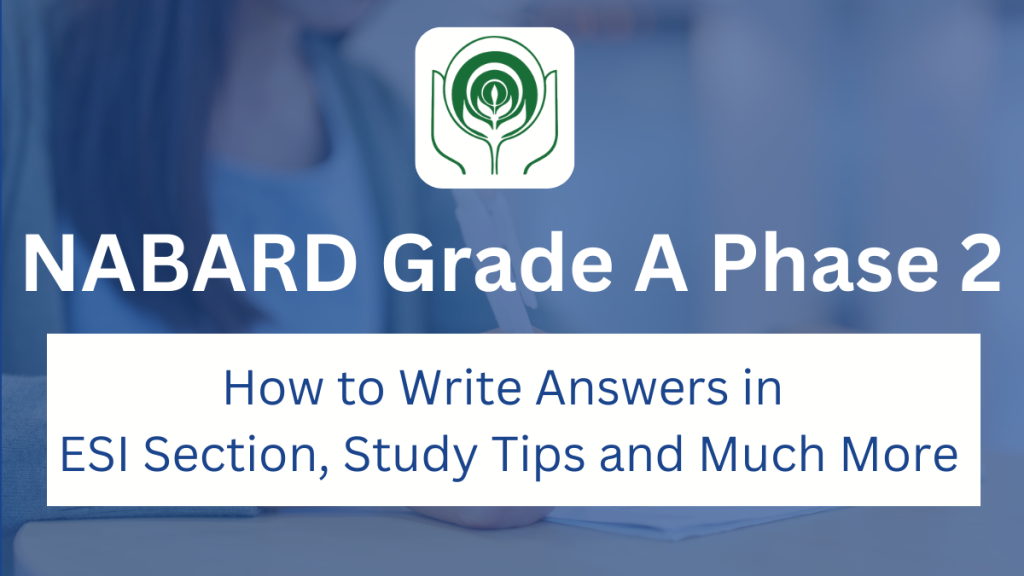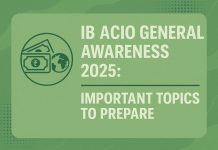The NABARD Phase 2 examination is a significant milestone for aspirants aiming to secure a prestigious career in the banking sector. With its challenging selection process, the National Bank for Agriculture and Rural Development (NABARD) ensures that only the best and brightest minds are chosen to serve the nation. While the NABARD Grade A Phase 1 exam assesses candidates through objective tests, the NABARD Grade A Phase 2 exam introduces a unique and critical dimension through its NABARD Descriptive Paper, nestled within the Economic and Social Issues (ESI) section. This NABARD Grade A descriptive paper serves as the litmus test, separating those who merely pass from those who excel in communicating their ideas effectively.
At the heart of the NABARD Grade A exam 2025, the Descriptive Question Paper in the ESI section of the NABARD exam presents candidates with a range of writing challenges, from essays and precis writing to letter compositions. It is this section that often becomes the deciding factor, distinguishing between those who clinch the coveted positions and those who narrowly miss the mark. Aspiring bankers must, therefore, equip themselves with the skills necessary to tackle and master the Descriptive Paper.

In this blog, we embark on a journey to demystify the art of excelling in the NABARD Grade A Phase 2 descriptive questions of NABARD Phase 2. We will provide a comprehensive guide rich with valuable insights and practical strategies to enhance your preparation and performance significantly. We aim to equip you with the tools and knowledge needed to confidently approach the NABARD descriptive paper, knowing you have the expertise to craft impressive answers.
At ixamBee, we understand the importance of this paper and the significance it holds in your NABARD Phase 2 journey. That’s why we offer comprehensive courses and resources designed to help you master this crucial examination aspect. Whether you are a beginner seeking to build a solid foundation or an experienced candidate looking to refine your skills, our courses cater to all proficiency levels. With expert guidance, practice materials, and a supportive learning environment, we aim to empower you to face the NABARD Grade A descriptive questions confidently and competently.
So, if you’re ready to embark on this transformative journey and unlock the door to a rewarding banking career, join us as we delve into the intricacies of mastering the NABARD descriptive paper in NABARD Grade A exam 2025, brought to you by ixamBee.
The Structure of the ESI Paper in NABARD Grade A Phase 2 Pattern
In the NABARD Grade A Phase 2 descriptive questions, the Economic and Social Issues (ESI) section is designed to evaluate a candidate’s understanding of the complex economic and social challenges that the country faces. This section consists of two parts: the Objective Test and the Descriptive Paper. The Objective Test assesses your knowledge through multiple-choice questions, while the Descriptive Paper evaluates your communication and analytical abilities. You can go through the detailed NABARD Grade A syllabus and exam pattern here.
The NABARD Grade A Descriptive Paper, a core component of the ESI section, comprises essay writing, precis writing, and letter writing. Candidates are required to write essays on contemporary topics of economic and social significance, create precise summaries of given passages, and compose formal and informal letters. This paper is not just a test of your knowledge but also your ability to present your ideas coherently and concisely.
Economic and Social Issues Paper in NABARD Phase 2 Pattern
NABARD has introduced a significant change in the NABARD Grade A Phase 2 pattern for the NABARD exam. The ESI paper is now both objective and descriptive, with the objective paper lasting 30 minutes and the descriptive paper lasting 90 minutes, each carrying 50 marks. As per this ne NABARD Phase 2 pattern the exam will include questions from Economic and Social Issues and Agriculture and Rural Development, with a special emphasis on Rural India for the General post. For the Specialist posts, Paper 2 will be based on the respective discipline. This change offers candidates a more comprehensive assessment of their knowledge and understanding of economic and social issues in the context of rural India. The updated NABARD Grade A Phase 2 pattern for 2025 is as follows.
| Exam Component | Duration | Maximum Marks |
| Objective (30 questions of 30 minutes) | 30 minutes | 50 Marks |
| Descriptive Paper (Candidates must answer 4 out of the 6 questions with two questions worth 15 marks each and the other two worth 10 marks each.) | 90 minutes | 50 Marks |
| Total | 120 Minutes | 100 Marks |
NABARD Grade A Phase 2 Syllabus 2025
The NABARD Grade A Phase 2 Syllabus for Economic and Social Issues is designed to assess candidates’ knowledge and understanding of key economic and social concepts, particularly in the context of rural India. This section of the examination typically covers a wide range of topics, including but not limited to economic development, poverty alleviation, social issues, rural development, and government schemes and policies aimed at promoting economic and social well-being.
Candidates must have a sound grasp of these subjects to excel in the exam. The questions in this section may encompass both theoretical concepts and practical aspects, making it essential for candidates to be well-versed in economic and social issues that impact the rural landscape. It is advisable for aspirants to refer to the official NABARD Grade A exam guide for a detailed syllabus to ensure comprehensive preparation.
Understanding the NABARD Grade A Phase 2 syllabus is crucial for successfully tackling the NABARD Grade A descriptive paper in this stage of the exam. The NABARD Phase 2 exam pattern includes both objective and descriptive question papers, with the latter focusing on essay and letter writing. Familiarity with the NABARD Grade A Phase 2 pattern and the nature of NABARD Grade A Phase 2 descriptive questions allows candidates to approach the exam with a well-structured plan. By reviewing the NABARD Phase 2 question paper and practicing relevant topics, candidates can efficiently prepare for the NABARD descriptive paper, improving their chances of clearing this critical stage.
| Subject | Topics |
| Economic and Social Issues | Nature of Indian Economy, Economic Development and Underdevelopment, Globalization, and Economic ReformsInflation and its Impact, Poverty Alleviation and Employment Generation, Population Trends and Policies, Agriculture and Food Security, Industrial Policies and Regional ImbalancesBanking and Financial Sector Reforms, Globalization, IMF, World Bank, and WTO, Social Structure, Multiculturalism, and GenderEducation System and Policy, Social Justice and Human Development, Current Economic & Social Issues |
NABARD Grade A Phase 2 Preparation Strategy: Descriptive Question Paper
To excel in the NABARD Grade A Phase 2 descriptive questions focused on Economic and Social Issues, consider the following comprehensive NABARD preparation strategies. These tips are designed to help you craft well-structured responses in essay writing, precis writing, and letter composition, ensuring a balanced approach to all exam components. Additionally, the NABARD Grade A Phase 2 Online Course, like those offered by ixamBee, can provide valuable resources, practice exercises, and expert guidance to enhance your skills further.
- Structured Study Schedule: Begin your preparation by crafting a well-structured study schedule specifically tailored to the Economic and Social Issues paper. This schedule should allocate time for essay writing, precis writing, and letter composition, ensuring a balanced approach to all components for the NABARD descriptive paper. Consider enrolling in online courses, such as those offered by ixamBee, to complement your preparation and gain access to expert guidance.
- Allocate Time Wisely: Within your schedule, allocate dedicated time for each aspect of the Descriptive Question Paper. Separate sessions for each syllabus aspect will ensure that you give equal attention to all these components. Online courses like those on ixamBee can provide additional practice exercises to refine your skills.
- Reading Comprehension and Analysis: Enhance your reading comprehension and analysis skills by accessing reputable sources like newspapers, economic journals, and magazines. Online courses, such as those available on ixamBee, often provide recommended reading materials tailored to the NABARD Phase 2 syllabus, ensuring you focus on the most pertinent content. You should also take care to brush up on your general awareness and economics knowledge as well. You can do so with ixamBee’s Beepedia. This approach allows you to build a strong foundation for understanding contemporary economic and social issues, and online courses can provide interactive lessons and expert insights.
- Effective Reading Strategies: Develop various reading strategies, including skimming, scanning, and annotating, to extract and retain information from your reading materials efficiently for the NABARD Grade A descriptive paper. Regular practice in summarizing articles and critically analyzing their primary arguments will sharpen your reading skills. Online courses, like those conducted by ixamBee, may offer dedicated sessions to improve your reading techniques and analysis.
- Study the Contemporary Topics: Prioritize topics that are contemporary and directly related to economic and social issues. Stay updated with current affairs, government policies, and recent economic developments to identify suitable essay themes that resonate with examiners. This approach not only showcases your awareness but also your ability to engage with the ongoing socioeconomic discourse. Online courses from ixambee can provide updated content and discussions on current issues.
- Essay Structure: Your essay’s structure is crucial for success. Create a framework with a compelling introduction, well-organized body paragraphs with supporting evidence and arguments, and a concise conclusion summarizing your main points. Ensure logical flow and coherence throughout your essay in the NABARD Grade A Phase 2 descriptive questions to effectively convey your ideas. By adhering to this structure, you present your arguments clearly and persuasively, and online courses may offer sample essays and feedback to improve your writing skills further.
You can sum up all these NABARD descriptive paper preparation strategies with ixamBee’s NABARD Grade A/B Descriptive Online Course. With individual performance feedback, live doubt-clearing sessions and much more, our course is guaranteed to give your descriptive writing skills a boost that will reflect in your NABARD Grade A merit list.
Mistakes to Avoid While Preparing for the ESI Descriptive Question Paper in NABARD Phase 2
- Lack of Clarity: One common pitfall in the ESI descriptive question paper that candidates make is the lack of clarity. It’s crucial to present your ideas in a clear and coherent manner. Simply put, your answers should have an introduction, a body, and a conclusion. Avoid vague or ambiguous language, and ensure your arguments and explanations are easily understandable.
- Insufficient Analysis: Many candidates fail to provide in-depth analysis in their NABARD Grade A descriptive paper answers. Merely stating facts or opinions without delving into the underlying reasons or implications can hinder the quality of your responses. Make sure to analyze the topic and provide a well-rounded perspective critically.
- Wordiness: Overly long and convoluted answers can negatively impact your score. Examiners appreciate concise, to-the-point responses. Be mindful of your word count, and avoid unnecessary verbosity that doesn’t contribute to the substance of your answer.
- Ignoring Word Limits: Not adhering to specified word limits is a standard error. Some candidates write excessively long responses, which not only consumes valuable time but can also lead to penalty points. On the other hand, writing extremely brief answers may lack the depth required to earn high marks. Striking the right balance is crucial in the NABARD Grade A descriptive paper.
- Lack of Proofreading: Failing to proofread your answers can result in grammatical errors, typos, and structural issues that detract from the overall quality. Always allocate a few minutes for proofreading at the end of your writing to correct mistakes and ensure coherence in your NABARD Grade A Phase 2 descriptive questions.
- The Importance of Mock Tests: Mock tests are invaluable for honing your skills, allowing you to identify your strengths and weaknesses. They simulate actual exam conditions, providing a platform to apply your preparation, and the detailed feedback from mock test performance helps you refine your strategy and focus on areas that require improvement. Taking the NABARD Phase 2 mock tests familiarizes you with the examination environment, builds confidence, and helps you manage time effectively, ensuring that you are well-prepared and composed on the day of the actual exam.
- Suggesting Practice Papers and Resources: To excel in descriptive answers, it’s essential to practice with various sample papers and resources. Find reputable books, websites, and courses like ixamBee that offer practice materials and previous year papers of NABARD Phase 2. These resources can expose you to different question types and provide valuable insights.
Tips for Self-Evaluation while Preparing for the Descriptive Question Paper in NABARD Phase 2
- Regular Self-Assessment: Regular self-assessment is a fundamental aspect of adequate preparation. Allocate time after practice sessions to review your answers. Analyze your performance in the NABARD descriptive answers objectively, identifying areas where you excelled and those that need improvement. Pay attention to aspects such as clarity, coherence, and depth of analysis. Self-assessment helps you track your progress and tailor your study strategy accordingly.
- Identify Weaknesses: As you review your practice answers in the NABARD Grade A Phase 2 question paper, focus on identifying your weaknesses. Pinpoint recurring issues like grammatical errors, lack of clarity, or inadequate analysis. Recognizing your shortcomings is the first step toward improvement. Make a list of the areas you need to work on, such as improving your vocabulary, enhancing sentence structure, or refining your ability to present arguments logically.
- Set Improvement Goals: After identifying your weaknesses, set clear and achievable improvement goals. Define specific targets, such as reducing grammatical errors in essays or enhancing the depth of analysis in precis writing. Break these goals into manageable tasks and track your progress. Regularly revisiting your goals and assessing your advancement will help you stay focused and motivated throughout your preparation.
Summing Up
Mastering the Descriptive Paper in NABARD Phase 2, particularly in the Economic and Social Issues (ESI) section, is a crucial step toward a successful career in the banking sector. With the right strategies, such as effective time management, continuous self-evaluation, and dedicated practice, candidates can significantly improve their writing and analytical skills, ensuring their success in this paper. It’s worth noting that ixamBee offers specialized courses tailored to the NABARD Phase 2 ESI exam, simplifying the preparation process. By incorporating these strategies and leveraging the support of ixamBee, you can confidently prepare for and excel in this critical examination, opening doors to a promising future in the banking field.
What is the importance of the NABARD Grade A Phase 2 syllabus for the descriptive paper?
The NABARD Grade A Phase 2 syllabus is vital for understanding the topics covered in the NABARD descriptive paper. It outlines the subjects and themes that may appear in the NABARD Grade A descriptive paper. Knowing the syllabus helps candidates prepare essays and letters that align with the NABARD Phase 2 question paper structure.
What kind of descriptive questions are asked in NABARD Grade A Phase 2?
NABARD Grade A Phase 2 descriptive questions include essays, precis writing, and letter drafting. These questions test candidates’ knowledge on various topics, including economics, agriculture, and social issues. Reviewing previous NABARD Grade A Phase 2 question papers can provide insights into the kind of themes and writing formats frequently asked in the exam.
How is the NABARD Grade A descriptive paper structured?
The NABARD Grade A descriptive paper typically consists of essay and letter writing questions, with specific word limits. The topics are often related to current events, agriculture, and rural development. Familiarity with the NABARD Phase 2 exam pattern helps candidates understand how to manage time effectively while ensuring a comprehensive response to each question.
What role does the NABARD Grade A Phase 2 pattern play in descriptive paper preparation?
The NABARD Grade A Phase 2 pattern provides a clear framework for how the descriptive paper is structured. By understanding the weightage of different sections and question types, such as essays and letters, candidates can better prepare. The NABARD Phase 2 pattern ensures balanced preparation across all sections of the descriptive paper.
How can previous NABARD Grade A Phase 2 question papers help in descriptive paper preparation?
Practicing with past NABARD Grade A Phase 2 question papers helps candidates familiarize themselves with the exam format and question styles. It also aids in understanding the time allocation for the NABARD descriptive paper and provides insight into potential essay and letter topics. This practice enhances the ability to write structured, well-organized responses.
What is the duration of the NABARD Grade A descriptive paper?
The NABARD Grade A descriptive paper is usually allocated a set time, generally around 90 minutes, within the overall NABARD Phase 2 exam pattern. Candidates must manage their time efficiently to complete both the essay and letter-writing sections. Time management plays a critical role in ensuring that all parts of the paper are completed effectively.
What should candidates focus on when preparing for the NABARD descriptive paper?
When preparing for the NABARD descriptive paper, candidates should focus on current events, economic and agricultural issues, and government schemes related to rural development. Following the NABARD Grade A Phase 2 syllabus and practicing essays and letters on these topics is essential. Reviewing the NABARD Phase 2 question paper also provides valuable guidance.
How can the NABARD Grade A Phase 2 exam pattern help in scoring well in the descriptive paper?
Understanding the NABARD Grade A Phase 2 exam pattern ensures that candidates are aware of the marks allocated for the descriptive section and the areas of focus. This knowledge helps in strategically preparing essays and letters that meet examiners’ expectations. Proper alignment with the NABARD Phase 2 pattern increases the chances of scoring well in the exam.
At ixamBee, we specialize in providing comprehensive online courses for government exams and online courses for government jobs. Our expertly designed courses for government jobs cater to a wide range of upcoming government exams. Whether you’re preparing for specific courses for government exams or seeking general guidance, ixamBee offers the resources like Beepedia, previous year papers, SSC CGL, SSC CHSL, SSC MTS and other mock tests to succeed in exams like RBI Grade B, SEBI Grade A, NABARD Grade A, RRB NTPC, SSC MTS, NIACL Assistant, and more.
Also Read:
EXIM Bank of India and its Role in India’s Exports
How to Crack SEBI Grade A Exam in 1st Attempt? Best Tips for You!
Understanding the Role of ECGC for Indian Exporters















